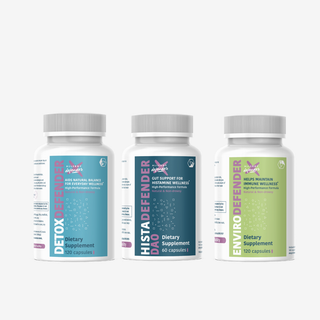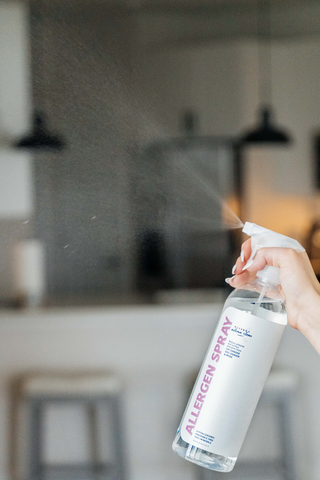Allergy testing identifies specific allergen triggers through skin prick tests (small allergen amount on pricked skin, 15-20 minute results) or blood tests (measures antibodies, good for young children/severe skin conditions). Testing benefits anyone with chronic respiratory symptoms (sneezing, runny nose, wheezing), skin issues (hives, eczema), or digestive problems. Results classified as positive (immune reaction confirmed), negative (not allergic), or inconclusive (weak reaction). Treatment options include second-generation antihistamines (Claritin, Zyrtec—less drowsy, longer relief), allergy shots (80% see improvement, $1,000-$4,000/year), sublingual immunotherapy ($75-$99/month), or Allergy Asthma Clean Allergen Spray by Allergy Defender (reduces 99% surface/95% airborne allergens, $24.99 first bottle).
Key Takeaways:
- Two main testing methods – skin prick tests (most common, quick 15-20 minute results, raised itchy bumps indicate allergies) or blood tests (measures antibody levels, better for young children or severe skin conditions)
- Common symptoms warrant testing – respiratory (itchy watery eyes, sneezing, congestion, wheezing), skin (hives, eczema, rashes), digestive (nausea, vomiting, diarrhea, cramps); testing possible at any age from infancy through adulthood
- Test result interpretation – positive (immune reaction confirmed; severity doesn't always predict real-life symptom intensity), negative (not allergic to tested substance, but not foolproof), inconclusive (weak/unclear reaction requires further testing)
- Second-generation antihistamines preferred – Claritin, Zyrtec, Allegra offer longer relief with less drowsiness than first-generation (Benadryl); Claritin showed 43% improvement vs 32% placebo; long-term use may have adverse effects (dementia risk, dry mouth, visual impairment)
- Immunotherapy options vary – allergy shots (80% see improvement, 60% permanent effect after 3-5 years, $1,000-$4,000/year, multiple visits); sublingual tablets ($75-$99/month, 3-5 years daily use); both require significant time/financial commitment
- Allergy Asthma Clean Allergen Spray by Allergy Defender – reduces 99% surface/95% airborne allergens (cat, dog, dust mite, cockroach); no medication/shots required; $24.99 first bottle, $10 or less refills; use as often as needed with avoidance strategies and lifestyle modifications
Have you ever woken up feeling like your eyes are glued shut and your nose is a faucet on high? Sneezing fits that leave you breathless and itchy skin that makes you want to crawl out of your own body? If so, you're likely one of the millions of people worldwide who struggle with allergies.
These pesky reactions can put a serious damper on your daily life, making it hard to enjoy the outdoors, focus at work, or even get a good night's sleep. But there's hope! Allergy testing can be a powerful tool for unmasking the mystery behind your allergies, allowing you to finally take control and breathe (and see!) a little easier.
What are Allergy Tests?
Allergy tests are medical "who done it" that help identify specific substances (allergens) that trigger your allergic reactions. These tests expose your body to a small amount of a suspected allergen and monitor your immune system's response.
There are two main types of allergy tests:
-
Skin prick test: This is the most common type of allergy testing. A small amount of the suspected allergen is placed on a prick on your skin's surface. If you're allergic, a raised, itchy bump will develop at the test site within 15-20 minutes.
-
Blood test: This test measures the amount of specific antibodies (immune system proteins) in your blood that are produced in response to allergens. While less common than skin prick tests, blood tests can be helpful for diagnosing allergies in young children or for people with severe skin conditions that make skin testing difficult. Skin prick tests can be a little itchy!
Who Should Get Tested?
Allergy testing can be beneficial for anyone who experiences chronic symptoms that suggest allergies. Here are some common symptoms that might warrant getting tested:
- Respiratory symptoms: Itchy, watery eyes, sneezing, runny or stuffy nose, coughing, wheezing, or difficulty breathing.
- Skin symptoms: Hives, eczema (inflamed, itchy skin), or recurrent skin rashes.
- Digestive symptoms: Nausea, vomiting, diarrhea, or stomach cramps (although these can also be caused by food intolerances, so testing can help differentiate between the two).
While allergy testing is generally safe for all ages, there are some considerations:
- Children: Allergy testing can be performed on children as young as infancy, however, skin prick tests may be more challenging for younger children who are wiggly or easily startled. Blood tests can be a good alternative in these cases.
- Adults: Allergy symptoms can develop at any point in life, so allergy testing is not just for children. If you suspect you may have developed new allergies as an adult, getting tested can help identify the triggers and guide your treatment plan.
The Testing Process: Demystifying Your Appointment
Allergy testing appointments typically involve two parts: a consultation with your doctor and the actual testing procedure itself. Here's a breakdown of what to expect:
Consultation:
- Review your medical history: Your doctor will discuss your symptoms in detail, including their frequency, severity, and any potential triggers you've noticed.
- Discuss medications: Be sure to inform your doctor about any medications you're currently taking, particularly antihistamines, as some medications can interfere with allergy test results.
- Determine the right tests: Based on your symptoms and medical history, your doctor will decide which type of allergy test (skin prick or blood test) is most suitable for you.
The Testing Procedure:
- Skin prick test: During this painless procedure, a healthcare professional will place a small drop of a suspected allergen extract on your skin (usually the forearm or back). A tiny prick will then be made through the drop using a sterile tool, allowing a miniscule amount of the allergen to enter your skin. This process is repeated for several different allergens. You'll then be monitored for 15-20 minutes to see if any raised, itchy bumps develop at the test sites.
- Blood test: A blood sample will be drawn from your arm. The blood will then be analyzed in a laboratory to measure the level of specific antibodies your body produces in response to different allergens.
Interpretation Time:
Once the testing is complete, your doctor will review your results and explain their significance. For skin prick tests, they'll measure the size and redness of any bumps that appeared. In the case of blood tests, they'll analyze the antibody levels. Your doctor will then discuss what the results mean in relation to your symptoms and allergies.
Understanding the Results: Cracking the Allergy Code
Allergy test results are typically classified as positive, negative, or inconclusive. Here's a breakdown of what each category means:
-
Positive Test: A positive result indicates that your immune system has reacted to a specific allergen. The size and severity of the reaction during the test (skin prick test) can sometimes provide clues about the potential severity of your allergic response in real-life situations. However, it's important to remember that test results don't always translate directly to the intensity of your symptoms. For me, my allergy to rye grass was intense. They had to give me an antihistimine immediately!
-
Negative Test: A negative result suggests that you're not allergic to the tested substance. However, it's negative results aren't always foolproof. In some cases, a negative test might occur if the allergen wasn't concentrated enough or if you were taking medications that suppressed your immune system's response.
-
Inconclusive Test: Sometimes, test results can be inconclusive, meaning the reaction was weak or unclear. This might necessitate further testing with different concentrations of the allergen or using alternative testing methods.
Here are some additional points to consider when interpreting your allergy test results:
- Limitations of Testing: Allergy tests can only identify specific allergens they are designed to detect. It's possible to have allergies to substances not included in the testing panel.
- Severity Doesn't Show: While the size of a reaction during a skin prick test might offer hints about potential allergy severity, it's not always a reliable predictor. You may have a strong positive test result but experience mild allergy symptoms in real life, and vice versa.
Next Steps After Testing: Charting Your Course to Allergy Relief
Now that you've undergone allergy testing and have a better understanding of your triggers, it's time to translate those results into action! Your doctor will work with you to develop a personalized treatment plan based on your specific allergies and the severity of your symptoms. This plan may include:
Types of Antihistamines and Effectiveness:
First-Generation Antihistamines: These older medications (like Benadryl) work quickly but can cause drowsiness as a side effect. They might be less effective for long-term symptom control and are not commonly recommended any more.
Second-Generation Antihistamines: These newer medications (like Claritin, Zyrtec, Allegra) are less likely to cause drowsiness and offer longer-lasting symptom relief. They are typically the preferred choice for most people. The Claritin effect, "in another trial, Claritin produced 43 percent improvement versus 32 percent with a placebo."
Allergy Shots and Other Options:
Allergy Shot: Also known as allergen immunotherapy or allergy desensitization, are a treatment option for individuals with allergic conditions. Cost about around $1,000 to $4,000 per year and require multiple visits to your doctor throughout the year. They work in two phases: the build-up phase and then the maintenance phase. About 80% of people see significant improvement in their allergy symptoms with allergy shots, but this decreases to only 60% having a permanent effect after three to five years of allergy shots. This is not an ideal route if you have a fear of needles.
Sublingual Immunotherapy (SLIT:) This alternative to traditional allergy shots involves taking allergy medication in tablet form that dissolves under the tongue. While still under development for some allergies, SLIT offers a potentially more convenient way to achieve desensitization for certain allergies. Cost ranges from $75 to $99 per month. Suggested daily use: three to five years for most effective results.
Allergen Spray: A powerful tool in the fight against allergens, proven effective against major allergens by up to 99% on surfaces and 95% in the air. Allergen Spray doesn't require medication, expensive devices, or shots. Spray your house for control of cat allergens, dog allergens, dust mite matter allergens, and cockroach matter allergens. Cost is very low (20.00 for your first bottle and 10.00 (or less) for refills) and can be used as often as needed.
Avoidance and Addressing the Concern:
Avoidance Strategies: Once you know your triggers, your doctor can help you develop strategies to minimize your exposure to them. This might involve avoiding pollen, pet dander, dust mites, or other allergens depending on your test results.
Lifestyle Modifications: In some cases, lifestyle modifications like using air purifiers, washing bedding in hot water regularly, or wearing a pollen mask during high pollen seasons can significantly reduce your exposure to allergens and improve your symptoms.
Address Your Concerns with your Doctor: This is the time to ask your doctor any questions you may have about your results, treatment options, or managing your allergies on a daily basis. Write down any questions before your appointment to make sure you have all questions answered. Don't hesitate to voice any concerns or preferences you have regarding treatment plans.
Developing a Long-Term Management Plan: Managing allergies often requires an ongoing effort. You and your doctor will work together to create a long-term management plan that fits your lifestyle and helps you achieve optimal control over your allergies.
Living with allergies can be frustrating and disruptive, but knowledge is power. Allergy testing can be a transformative tool, helping you unveil the mystery behind your symptoms and take control of your health. By understanding your specific triggers, you can develop a personalized management plan that allows you to breathe easier, live freer, and experience all that life has to offer.
Sources:
1.https://www.nytimes.com/2001/03/11/magazine/the-claritin-effect-prescription-for-profit.html


















